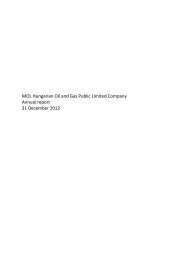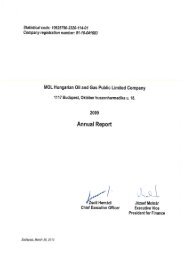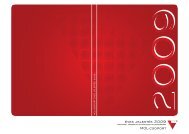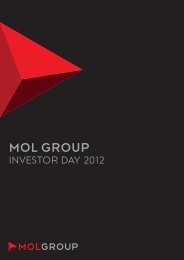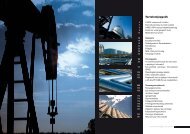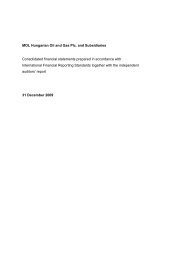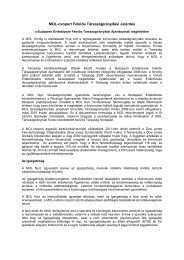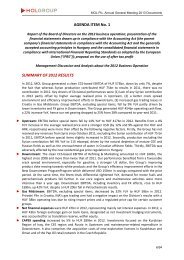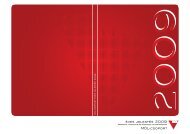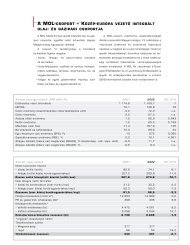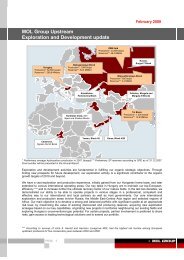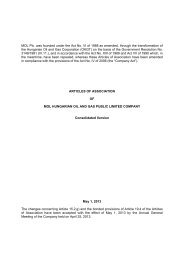MOL GROUP Annual Report
MOL GROUP Annual Report
MOL GROUP Annual Report
- No tags were found...
You also want an ePaper? Increase the reach of your titles
YUMPU automatically turns print PDFs into web optimized ePapers that Google loves.
The main role of Financial Risk Management (FRM) as part of the ERM is to handle short-term, market related risks.Commodity price, FX and interest rate risks are measured by using a complex model based on Monte Carlo simulation(which takes into account portfolio effects as well) and are managed – if necessary - with risk mitigation tools (such as swaps,forwards and options). This function concentrates on a 12-month time horizon. <strong>Report</strong>s on compliance with limits linkedto strategic and financial objectives of the Group are compiled for the senior management on a monthly basis wherebymitigation action plans are proposed by Risk Management on an ad-hoc basis when required.Integrated risk managementfunction – at workTransferring of excess operational risks is done by Insurance Management (IM). It means purchase of insurance, which is animportant risk mitigation tool used to cover the most relevant operational and liability exposures. The major insurance typesare: Property Damage, Business Interruption, Liability, and Control of Well Insurance. Due to the peculiarity of the insurancebusiness major tasks of this function are set around a yearly cycle (i.e. annual renewal of most insurance programs). Sinceinsurance is managed through a joint program for the whole group (including <strong>MOL</strong>, INA, Slovnaft, TVK, IES and SlovnaftPetrochemicals), <strong>MOL</strong> Group is able to exploit considerable synergy effects.Business Continuity Management (BCM) is the process of preparing for unexpected disruptions that have low probability foroccurrence but high impact. Business Continuity Plans (BCP) and Crisis Management (CM) processes, Incident Management,Disaster Recovery and other risk control programs (like regular engineering reviews) are crucial in such a business like <strong>MOL</strong>Group’s where operational risk exposure is significant as a result of the chemical and physical processes underlying most ofthe operations. The quality of both BCP and CM is often measured in financial terms when dealing with insurance agenciesduring annual renewals, and consequently may decrease insurance costs.Integrated risk management function – at workIt is an accentuated aim for Risk Management to deal with all of the external challenges (including new industry-specifictaxes) in order to support the stable and sustainable financial position of <strong>MOL</strong>. It is a necessity to have an effective andcomprehensive risk management as a prerequisite tool of good corporate governance. <strong>MOL</strong> Group can state that it hasdeveloped risk management function as an integral part of its corporate governance structure. This was confirmed by SAMResearch AG again in its 2010 benchmarking report for Dow Jones Sustainability Index that ranked <strong>MOL</strong>’s risk managementas one of the best in class with 88% performance, 28 percentage points above the sector’s average underlying <strong>MOL</strong>’swell-defined responsibility for risk and crisis management, our extensive risk definitions, the applications of risk mapping,quantification, stress testing and sensitivity analysis for all financial and non-financial risks and our well-defined risk responsestrategy.Multi-pillar system for managing a broad variety of risksIncorporation of the broadest variety of risks into one long-term, comprehensive and dynamic system is arranged byEnterprise Risk Management (ERM) on group level for all division. ERM integrates financial and operational risks along witha wide range of strategic and reputation risks. Following identification, different classes of risks are quantified using a unifiedmethodology. The time horizon of the model emphasises long term view (according to strategic horizons): up to 10 years andeven beyond, when analysing the variability of net present values. The ERM process identifies the most significant risks tothe performance of the company (both on divisional and on group levels) and calls for a decision to be made regarding whichrisks should be retained and which should be mitigated and how. Some of the risks are managed centrally, while some aredealt with the divisions, overseen by nominated risk owners. Risk Management regularly controls the realization of these riskmitigation actions – in a form of quarterly required reports from the risk owners.Valuable synergies can be exploited when risk is approached in a comprehensive wayThe existence of an integrated risk management function enables <strong>MOL</strong> to exploit the synergies between the above detailedpillars of risk management. The methodology and input sources of modeling financial risks are applied in ERM as well.Similarly, the accumulated information on operational risks gained through managing insurances is also an important factorin the ERM development. The results of ERM on operational risks (i.e. the impact hierarchy of operational risks) can give abetter direction to insurance management by highlighting which are those areas that shall be covered by insurance as a mustand which are those where further analysis is required to make decisions on how to manage the related risks. Both ERM andinsurance management produce inputs to BCM as a priority list of key areas to focus on. BCM and IM have anyway strongrelationship as they both deal with operational risk management. For example an effective BCM can reduce the exposure of<strong>MOL</strong> Group for business interruption risk and hence reduces the extent of insurance coverage to be bought. Risk awarenessculture across the whole organization had already been enhanced as well, especially via the group-wide involvement of thegroup’s divisions and units during ERM and BCM processes.Decision making support of capital allocationThe most important role of ERM is not just to provide information on which the most imperative risks are that <strong>MOL</strong> Groupfaces with, but to enable top management and the Board of Directors to make more educated decisions on investments,taking into consideration the risk profile of each project as well. In order to serve this purpose Group Risk Management isinvolved in the evaluation of each major project and potential acquisitions and divestitures through the utilization of its ERMcapabilities to provide opinion on capital allocation and financial headroom.Last year the whole oil and gas industry felt the aftermath of the oil spill in the Gulf of Mexico. In the meantime a red sludgeflood in Hungary further increased the importance of operational safety and the liability issue towards environment and civilsociety. Both these events demonstrated that in spite of disposing insurance programs, operating risks have knock-on effecton a company’s financial position and reputation. At <strong>MOL</strong> we made immediate steps in reconciling the status of operationalrisks in the Enterprise Risk Management (ERM) framework with current experiences and lessons learned. Together with thatwe re-validated our insurance program together with the Business Continuity Management (BCM).Integrated Risk ManagementFunction224 <strong>MOL</strong> Group annual report 2010 225



